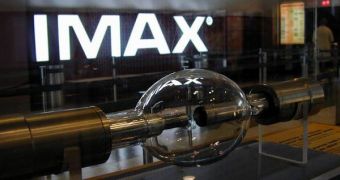The NASA American space agency, together with the Warner Bros. Pictures movie company, and the IMAX Corporation announced yesterday that they would again collaborate during the STS-125 Hubble Space Telescope servicing mission, when a number of IMAX 3D cameras would be taken to space, to document everything. In what will be one of the most complex shuttle missions to date, astronauts will perform five spacewalks over 11 days, and will attempt to bring the most venerable observatory in orbit to its prime again, at least until 2015.
“We have worked with IMAX on past Hubble missions and are excited about working with them again on the current Hubble mission. The Hubble Space Telescope continues to dazzle us with the splendor of our universe, and after the mission we look forward to many more years of awe-inspiring imagery. IMAX has developed innovative 3-D image capture and projection technology that creates a large-scale, immersive educational experience in which those of us on the ground are no longer passive observers of spaceflight, we're active participants,” NASA's acting Assistant Administrator for Public Affairs Bob Jacobs says in a press release from the agency's headquarters in Washington, DC.
The new IMAX movie, entitled Hubble 3D, will be ready by spring 2010, the parts involved in the effort have announced. Footage from all the cameras that will be carried by the astronauts will be combined with a number of highly detailed and complex images that Hubble took over the years, in an experience that NASA describes as breathtaking. Already, IMAX engineers have instructed the seven-member crew that will fly the Atlantis space shuttle to Hubble on how to use the cameras. The training took place at the space agency's Johnson Space Center, in Houston, Texas.
“It's been said that the IMAX experience is the next best thing to being in space, and with IMAX 3D, the audience really is there. Fifteen years ago, we made a film about space exploration that included Hubble, when it started sending back the first images. Today, we have Hubble's entire phenomenal legacy of data to explore. With IMAX 3D, we can transport people to galaxies that are 13 billion light years away – back to the edge of time. Real star travel is here at last,” the Director and Producer of the new film, Toni Myers, added.
According to the layout agreed on by NASA and the IMAX Corporation, one camera will be mounted outside the crew cabin, in the cargo bay, to catch overview images of the entire proceedings. Moreover, the mission commander and the shuttle pilot will also have to manipulate mobile cameras, in addition to performing their usual assignments.
Hopefully, they will catch how the two spacewalking teams work together with Atlantis' robotic arm for some of the most complex tasks ever undertaken in space. In short, many of the telescope's high-precision instruments need to be refurbished or replaced. And there is absolutely no room for error.

 14 DAY TRIAL //
14 DAY TRIAL //